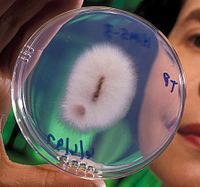
Photo from wikipedia
Abstract This study aimed to isolate a biological agent that could inhibit the growth of Fusarium oxysporum f. sp. niveum (Fon), and reduce the incidence of Fusarium wilt in watermelon.… Click to show full abstract
Abstract This study aimed to isolate a biological agent that could inhibit the growth of Fusarium oxysporum f. sp. niveum (Fon), and reduce the incidence of Fusarium wilt in watermelon. The dual-culture plate assay was used to screen biocontrol agents against Fon. Six strains were isolated from the watermelon rhizosphere, and the WB strain showed the strongest antifungal activity against Fon. According to sequence analysis of the 16S rRNA gene, gyrA gene and gyrB gene, the WB strain was named Bacillus sp. WB. The cell-free supernatant (CFS) from the death phase had the strongest antifungal activity against Fon compared to those from the exponential and stationary phases. Scanning and transmission electron microscopy analysis demonstrated that CFS from Bacillus sp. WB inhibited the growth of Fon by affecting cellular morphology and disrupted cell walls and membranes. Pot experiments were performed to evaluate the biocontrol potential of Bacillus sp. WB. Compared to the Fon-infected and untreated with Bacillus sp. WB (F treatment), the densities of bacteria, fungi, actinomycetes and total microbes were increased, and the density of Fusarium was decreased in the rhizosphere of watermelon infected with Fon and inoculated with Bacillus sp. WB (FW treatment). The relative abundances of Proteobacteria, Actinobacteria, Firmicutes, Acidobacteria, Gemmatimonadetes, Mycobacterium, Rhodanobacter, Streptomyces, Devosia and Bacillus were increased in the rhizosphere of watermelon infected with Fon and inoculated with Bacillus sp. WB compared to the Fon-infected and untreated with Bacillus sp. WB. Importantly, the incidence of Fusarium wilt was decreased in watermelon plants treated with Bacillus sp. WB. Our data confirmed that Bacillus sp. WB could inhibit the growth of Fon, change structure of microbial community and enhance the health index of watermelon plants. The findings can serve as a stimulus for further research about antifungal compounds from Bacillus sp. WB and contribute to an effective and promising biological agent for Fusarium wilt control management.
Journal Title: Biological Control
Year Published: 2020
Link to full text (if available)
Share on Social Media: Sign Up to like & get
recommendations!